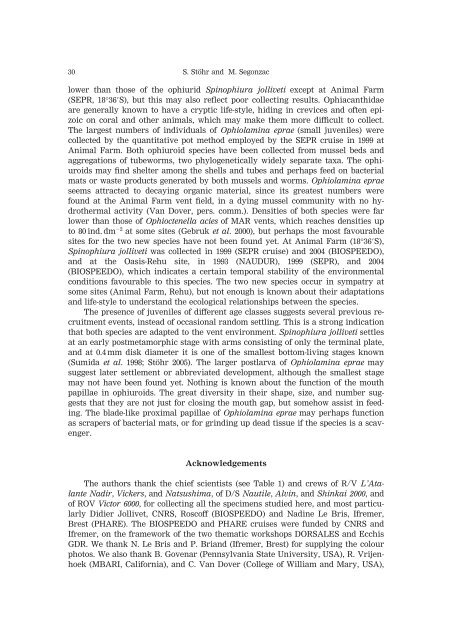from Hydrothermal Vents in the East Pacific - Station Biologique de ...
from Hydrothermal Vents in the East Pacific - Station Biologique de ...
from Hydrothermal Vents in the East Pacific - Station Biologique de ...
Create successful ePaper yourself
Turn your PDF publications into a flip-book with our unique Google optimized e-Paper software.
30 S. Stöhr and M. Segonzac<br />
lower than those of <strong>the</strong> ophiurid Sp<strong>in</strong>ophiura jolliveti except at Animal Farm<br />
(SEPR, 18°36S), but this may also reflect poor collect<strong>in</strong>g results. Ophiacanthidae<br />
are generally known to have a cryptic life-style, hid<strong>in</strong>g <strong>in</strong> crevices and often epizoic<br />
on coral and o<strong>the</strong>r animals, which may make <strong>the</strong>m more difficult to collect.<br />
The largest numbers of <strong>in</strong>dividuals of Ophiolam<strong>in</strong>a eprae (small juveniles) were<br />
collected by <strong>the</strong> quantitative pot method employed by <strong>the</strong> SEPR cruise <strong>in</strong> 1999 at<br />
Animal Farm. Both ophiuroid species have been collected <strong>from</strong> mussel beds and<br />
aggregations of tubeworms, two phylogenetically wi<strong>de</strong>ly separate taxa. The ophiuroids<br />
may f<strong>in</strong>d shelter among <strong>the</strong> shells and tubes and perhaps feed on bacterial<br />
mats or waste products generated by both mussels and worms. Ophiolam<strong>in</strong>a eprae<br />
seems attracted to <strong>de</strong>cay<strong>in</strong>g organic material, s<strong>in</strong>ce its greatest numbers were<br />
found at <strong>the</strong> Animal Farm vent field, <strong>in</strong> a dy<strong>in</strong>g mussel community with no hydro<strong>the</strong>rmal<br />
activity (Van Dover, pers. comm.). Densities of both species were far<br />
lower than those of Ophioctenella acies of MAR vents, which reaches <strong>de</strong>nsities up<br />
to 80 <strong>in</strong>d. dm 2 at some sites (Gebruk et al. 2000), but perhaps <strong>the</strong> most favourable<br />
sites for <strong>the</strong> two new species have not been found yet. At Animal Farm (18°36S),<br />
Sp<strong>in</strong>ophiura jolliveti was collected <strong>in</strong> 1999 (SEPR cruise) and 2004 (BIOSPEEDO),<br />
and at <strong>the</strong> Oasis-Rehu site, <strong>in</strong> 1993 (NAUDUR), 1999 (SEPR), and 2004<br />
(BIOSPEEDO), which <strong>in</strong>dicates a certa<strong>in</strong> temporal stability of <strong>the</strong> environmental<br />
conditions favourable to this species. The two new species occur <strong>in</strong> sympatry at<br />
some sites (Animal Farm, Rehu), but not enough is known about <strong>the</strong>ir adaptations<br />
and life-style to un<strong>de</strong>rstand <strong>the</strong> ecological relationships between <strong>the</strong> species.<br />
The presence of juveniles of different age classes suggests several previous recruitment<br />
events, <strong>in</strong>stead of occasional random settl<strong>in</strong>g. This is a strong <strong>in</strong>dication<br />
that both species are adapted to <strong>the</strong> vent environment. Sp<strong>in</strong>ophiura jolliveti settles<br />
at an early postmetamorphic stage with arms consist<strong>in</strong>g of only <strong>the</strong> term<strong>in</strong>al plate,<br />
and at 0.4 mm disk diameter it is one of <strong>the</strong> smallest bottom-liv<strong>in</strong>g stages known<br />
(Sumida et al. 1998; Stöhr 2005). The larger postlarva of Ophiolam<strong>in</strong>a eprae may<br />
suggest later settlement or abbreviated <strong>de</strong>velopment, although <strong>the</strong> smallest stage<br />
may not have been found yet. Noth<strong>in</strong>g is known about <strong>the</strong> function of <strong>the</strong> mouth<br />
papillae <strong>in</strong> ophiuroids. The great diversity <strong>in</strong> <strong>the</strong>ir shape, size, and number suggests<br />
that <strong>the</strong>y are not just for clos<strong>in</strong>g <strong>the</strong> mouth gap, but somehow assist <strong>in</strong> feed<strong>in</strong>g.<br />
The bla<strong>de</strong>-like proximal papillae of Ophiolam<strong>in</strong>a eprae may perhaps function<br />
as scrapers of bacterial mats, or for gr<strong>in</strong>d<strong>in</strong>g up <strong>de</strong>ad tissue if <strong>the</strong> species is a scavenger.<br />
Acknowledgements<br />
The authors thank <strong>the</strong> chief scientists (see Table 1) and crews of R/V L’Atalante<br />
Nadir, Vickers, and Natsushima, of D/S Nautile, Alv<strong>in</strong>, and Sh<strong>in</strong>kai 2000, and<br />
of ROV Victor 6000, for collect<strong>in</strong>g all <strong>the</strong> specimens studied here, and most particularly<br />
Didier Jollivet, CNRS, Roscoff (BIOSPEEDO) and Nad<strong>in</strong>e Le Bris, Ifremer,<br />
Brest (PHARE). The BIOSPEEDO and PHARE cruises were fun<strong>de</strong>d by CNRS and<br />
Ifremer, on <strong>the</strong> framework of <strong>the</strong> two <strong>the</strong>matic workshops DORSALES and Ecchis<br />
GDR. We thank N. Le Bris and P. Briand (Ifremer, Brest) for supply<strong>in</strong>g <strong>the</strong> colour<br />
photos. We also thank B. Govenar (Pennsylvania State University, USA), R. Vrijenhoek<br />
(MBARI, California), and C. Van Dover (College of William and Mary, USA),
















